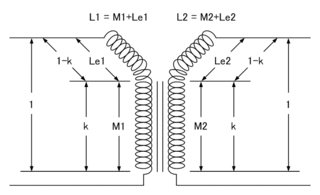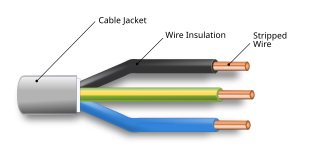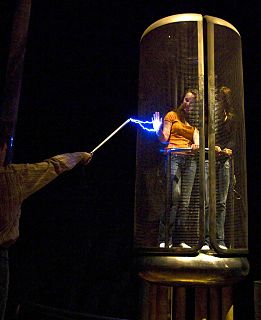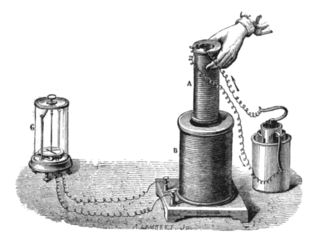
An electromagnetic coil is an electrical conductor such as a wire in the shape of a coil, spiral or helix. Electromagnetic coils are used in electrical engineering, in applications where electric currents interact with magnetic fields, in devices such as electric motors, generators, inductors, electromagnets, transformers, and sensor coils. Either an electric current is passed through the wire of the coil to generate a magnetic field, or conversely an external time-varying magnetic field through the interior of the coil generates an EMF (voltage) in the conductor.

An electrical insulator is a material whose internal electric charges do not flow freely; very little electric current will flow through it under the influence of an electric field. This contrasts with other materials, semiconductors and conductors, which conduct electric current more easily. The property that distinguishes an insulator is its resistivity; insulators have higher resistivity than semiconductors or conductors.

In electrical engineering, two conductors are said to be inductively coupled or magnetically coupled when they are configured such that a change in current through one wire induces a voltage across the ends of the other wire through electromagnetic induction. A changing current through the first wire creates a changing magnetic field around it by Ampere's circuital law. The changing magnetic field induces an electromotive force in the second wire by Faraday's law of induction. The amount of inductive coupling between two conductors is measured by their mutual inductance.

An electrical cable is an assembly of one or more wires running side by side or bundled, which is used to carry electric current.

An Earth-leakage circuit breaker (ELCB) is a safety device used in electrical installations with high Earth impedance to prevent shock. It detects small stray voltages on the metal enclosures of electrical equipment, and interrupts the circuit if a dangerous voltage is detected. Once widely used, more recent installations instead use residual current circuit breakers which instead detect leakage current directly.
Induction heating is the process of heating an electrically conducting object by electromagnetic induction, through heat generated in the object by eddy currents. An induction heater consists of an electromagnet, and an electronic oscillator that passes a high-frequency alternating current (AC) through the electromagnet. The rapidly alternating magnetic field penetrates the object, generating electric currents inside the conductor called eddy currents. The eddy currents flowing through the resistance of the material heat it by Joule heating. In ferromagnetic materials like iron, heat may also be generated by magnetic hysteresis losses. The frequency of current used depends on the object size, material type, coupling and the penetration depth.
In an electrical system, a ground loop or earth loop occurs when two points of a circuit both intended to be at ground reference potential have a potential between them. This can be caused, for example, in a signal circuit referenced to ground, if enough current is flowing in the ground to cause two points to be at different potentials.

Electrical wiring is an electrical installation of cabling and associated devices such as switches, distribution boards, sockets and light fittings in a structure.
A power cable is an electrical cable, an assembly of one or more electrical conductors, usually held together with an overall sheath. The assembly is used for transmission of electrical power. Power cables may be installed as permanent wiring within buildings, buried in the ground, run overhead, or exposed.

Electromagnetic shielding is the practice of reducing the electromagnetic field in a space by blocking the field with barriers made of conductive or magnetic materials. Shielding is typically applied to enclosures to isolate electrical devices from their surroundings, and to cables to isolate wires from the environment through which the cable runs. Electromagnetic shielding that blocks radio frequency electromagnetic radiation is also known as RF shielding.
In an electrical installation, an earthing system or grounding system connects specific parts of that installation with the Earth's conductive surface for safety and functional purposes. The point of reference is the Earth's conductive surface. The choice of earthing system can affect the safety and electromagnetic compatibility of the installation. Regulations for earthing systems vary considerably among countries, though most follow the recommendations of the International Electrotechnical Commission. Regulations may identify special cases for earthing in mines, in patient care areas, or in hazardous areas of industrial plants.

Fleming's left-hand rule for electric motors is one of a pair of visual mnemonics, the other being Fleming's right-hand rule. They were originated by John Ambrose Fleming, in the late 19th century, as a simple way of working out the direction of motion in an electric motor, or the direction of electric current in an electric generator.

In electrical engineering, isolated-phase bus (IPB), also known as Phase-isolated Bus (PIB) in some countries, is a method of construction for circuits carrying very large currents, typically between a generator and its step-up transformer in a steam or large hydroelectric power plant.

A surge arrester is a device to protect electrical equipment from over-voltage transients caused by external (lightning) or internal (switching) events. Also called a surge protection device (SPD) or transient voltage surge suppressor (TVSS), this class of device is used to protect equipment in power transmission and distribution systems. The energy criterion for various insulation material can be compared by impulse ratio. A surge arrester should have a low impulse ratio, so that a surge incident on the surge arrester may be bypassed to the ground instead of passing through the apparatus.

A lightning rod or lightning conductor (UK) is a metal rod mounted on a structure and intended to protect the structure from a lightning strike. If lightning hits the structure, it will preferentially strike the rod and be conducted to ground through a wire, instead of passing through the structure, where it could start a fire or cause electrocution. Lightning rods are also called finials, air terminals or strike termination devices.

A corona ring, also called an anti-corona ring, is a toroid of conductive material, usually metal, which is attached to a terminal or other irregular hardware piece of high voltage equipment. The role of the corona ring is to distribute the electric field gradient and lower its maximum values below the corona threshold, either preventing corona discharge entirely or transferring its destructive effects from the valuable hardware to the expendable ring. Corona rings are used on very high voltage power transmission insulators and switchgear, and on scientific research apparatus that generates high voltages. A very similar related device, the grading ring is used around insulators.

An electrical conduit is a tube used to protect and route electrical wiring in a building or structure. Electrical conduit may be made of metal, plastic, fiber, or fired clay. Most conduit is rigid, but flexible conduit is used for some purposes.
















